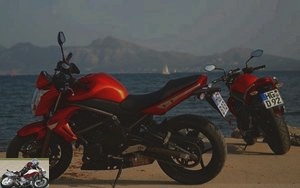Menus
- Discovery
- In the saddle
- Contact
- City
- Highway
- Departmental
- Comfort
- Brakes
- Convenient
- Consumption
- Accessories
- Conclusion
3-day twin-cylinder roadster test
The Kawasaki ER6n is Akashi’s twin-cylinder roadster initially introduced in 2005, which has achieved unprecedented success with more than 38,000 units sold in Europe. Barely three years later, the roadster underwent a slight facelift, mainly aesthetic, but also affecting the engine and ABS. So, how successful is this new ER-6n? Test….
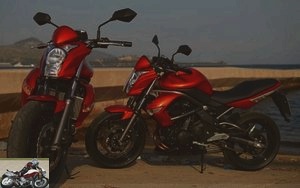
Discovery
The 2009 Kawasaki ER6n is not far from the 2008 model. From a distance, you can recognize the same lines, the same tubular chassis, the same widely visible eccentric shock absorber and the exhaust under the frame. You have to get closer to notice the differences. The new lines are tighter to replace some previous curves. In fact, the new ER6n seems more aggressive, in particular by its double front optics, the side covers integrating the indicators, the tapered rear LED light, the aluminum passenger handles with rough angles and the hexagonal mirrors. We also notice a smaller wheel arch and a larger radiator. Finally, in detail, the shape of the front fender reveals two edges.
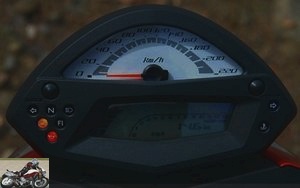
The new dashboard flattens out in terms of exterior shape and changes visually completely, separating in particular in two, analog at the top with the speedometer, digital at the bottom with the tachometer (i.e. exactly the opposite of the previous vintage), the clock, the totalizer and the partial double trip. The real plus here is the serial integration of the fuel gauge. The analog speedometer is not as precise as the old one with barely legible graduations, but it looks much better on a beautiful white background. The night lighting is all the more superb.
The warnings are on the handlebars on the left.
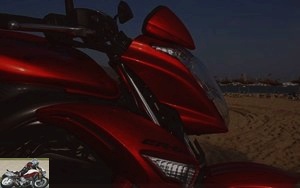
In the saddle
The feet do not touch the ground any better than on the old model for the 1.70m pilot. On the other hand, the 2009 vintage offers a saddle 20mm lower and 10mm narrower, which better touches the ground. The difference will be especially noticeable for women, as the majority of testers find it easy to put both feet flat. With a 785mm seat, the ER6n falls into the low roadster category. The riding position is the same, although the new saddle and the noticeably narrower tank tend to position the rider further forward, the arms more flexed and ultimately allow the bike to grip the bike better..
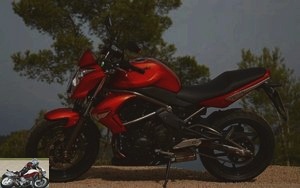
Contact
The counter resets. The bike exudes the sound so characteristic of an ER6n with only 500 km on the clock, barely running in. Because the sound changes – and becomes hoarse – after a few thousand kilometers.
The visibility of the new mirrors is better than the old model. We only see a third of the elbows there, compared to more than half previously. On the other hand, the left retro is a little more sensitive to vibrations..
The first two gears seem smoother than on the old model, the twin a little less brutal when the throttle is put under 5,000 revs. Then there is a more sensitive elastic effect where the revving is clean and rapid, peaking after 9,000 rpm and up to the red zone at 11,000 rpm. This is how the first goes up to 80 km / h and the second up to 120 km / h.

City
Lightweight, agile, the ER6n weaves its way around, confirming excellent handling, reinforced by an excellent turning radius. The U-turn is done easily and effortlessly on a street. In fact, its turning radius is only 3.2 meters. The featherweight, unchanged of 200 kilos fully loaded is also a big factor, especially since it is positioned well at the bottom.
If the engine knocks below 2,000 rpm in 6th gear, it will wind up quietly between 2,000 and 4,000 rpm in the last gear. On the other hand, the rapid climbs in the first reports encourage to play and go up in the towers for frank acceleration..
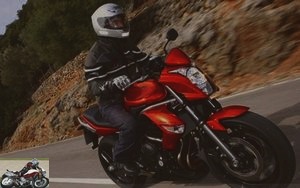
Highway
The ER6 quickly climbs up the towers to reach 160 km / h without any problem and without any particular strain on the neck. The new, larger speedometer plays a positive role in offering 10 km / h better protection than the old model.
At just 110 km / h at 5,000 rpm, the ER6 then picks up 20 km / h every 1,000 rpm, even if the generous speedometer significantly overestimates actual speed. Almost exact under 100 km / h, the 150 km / h on the odometer is actually calibrated to 140 km / h.
Unperturbed, even at speeds of over 200 km / h, the ER6 suffers from no negative reactions, neither fluttering nor darting. It remains impeccable on the trajectory and without requiring any particular effort, except for the neck above 160 km / h.
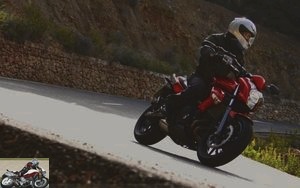
Departmental
The ER6n finds its favorite playground on small roads. Straightforward acceleration, enormous engine braking, the twin-cylinder allows you to string together the virolos at a sustained ride pace without changing gears and barely touching the brakes, including in the mountains. The 3rd gear then turns out to be the best gear. If the pace needs to pick up, the ER6 will then more readily alternate between 2nd and 3rd. The small displacement allows you to open big throttle with a free kick without side reaction. The reactions are then healthy and unsurprising. You really have to take the road for a track to find the limits of the motorcycle, forgetting all safety on any open.
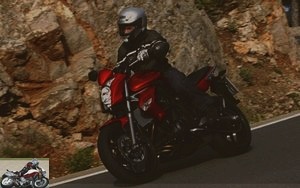
Comfort
The suspensions are still firm, but the ER6n jumps less on the defects of the road than the previous vintage. The saddle is not really soft, but the comfort is acceptable without causing pain in the buttocks after 250 km of virolos in the mountains. Comfort varies here depending on the rider profile: small riders will find their happiness there, more generous riders will find it hard because not wide enough.
There are much less vibrations than in the previous vintage, and the impressions of ants in the hands at the end of the day have disappeared. The work carried out on the reduction of vibrations – its main previous defect – has borne fruit; it’s undeniable.
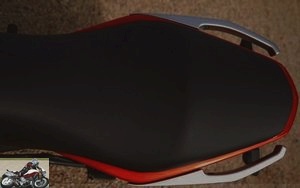
Brakes
The ER6n brakes hard, even very hard, offering a good feeling. Strong pressure on the rear and / or front brake does not activate the ABS. You really have to start working out, grab the right grip and smash the rear brake to feel the ABS kick in, especially at the rear, before the front. Very large sprinklers entering at the last moment on the brakes before a turn and putting a lot of weight on the front may then have a few surprises with the activation of the ABS.
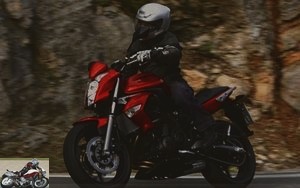
Convenient
There is a little more room under the saddle than on the old model, but not enough to fit more than a U.
There are always under the saddle, the tie-down hooks as well as the metal wires for the helmet.
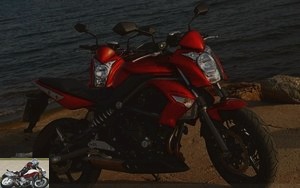
Consumption
Consumption remains identical to the previous model…. overall under 5 liters per hundred, except in the case of predominantly mountainous roads where consumption can then go up to 7 liters. If the shape of the tank has been changed, the capacity remains the same at 15.5 liters, and therefore allows a range of around 300 km, the ER6n being one of the most sober motorcycles on the market in this displacement, even the more fuel-efficient of all displacements above 500 cm3.
Accessories
Kawasaki offers with this 2009 vintage:
- a new specific nose screen
- a tank guard
- a 30-liter top-case in the colors of the motorcycle
- a rear seat cover
Conclusion
Kawasaki made the right choices without taking any real risk with this new vintage. The ER6n benefits from the small touches of necessary improvements (points that could be improved) compared to the previous vintage, especially in terms of vibrations. In short, it’s the same bike, only better. Aesthetically, the touch-ups – especially at the speedometer, taillights, scoops and mirrors – give it a real boost and above all a sportier look. With the habit of driving the old ER6n on a regular basis, the new one feels smoother (but not linear), more fun to drive and easier to register on the corner. The engine has become more flexible with less brutality on the go-around, and less knocking on intermediate gears when picking up at low speed. This is still perfectly suited to the beginner, who will feel at ease there even more quickly than before. At the same price (the official price of the new model has not yet been determined at the time of writing), I will favor the new vintage for its handling and its even easier character than the old one. On the other hand, there are still many old ER6n in dealerships, and we can estimate that the 2007 models will therefore benefit from discounts of up to 10% at the end of 2008 *, the new version due to arrive in dealership one year. shortly before Christmas. In short, the 2009 vintage is now fully completed and should not move for several years..
* this is the sole responsibility of the editor of these lines, Kawasaki having neither denied nor confirmed anything.
Strong points
- maneuverability
- less brutal engine with less vibrations
- autonomy
Weak points
- Saddle
- New meter, more aesthetic, but less precise
Competitors: Ducati Mostro 620, Honda CBF 500, Honda CBF 600, Suzuki SV 650
User reactions and testimonials on the
testing forum.
User reactions and testimonials on the
motorcycle guide
Related articles
-
2009 Kawasaki ER-6f ABS motorcycle test
Test of the faired version of the Kawasaki ER6 ABS twin-cylinder The Kawasaki ER6f is the streamlined version of Akashi’s ER6 twin-cylinder roadster…
-
2012 Kawasaki ER-6n motorcycle test
New test: Kawasaki ER 6N: Sparkling with mischief ! Appeared in 2006 and restyled in 2009, the ER6 N gets a new facelift that makes it even sexier,…
-
Kawasaki Z 750 R motorcycle test
The Z super Roadster version ! There are emblematic models by their distribution, the commercial enthusiasm they arouse. The Z 750 is in this vein. With…
-
Kawasaki Versys 1000 motorcycle test
La Z goes green Eternal absent from the Kawasaki range, apart from the unlikely KLV 1000 (Suzuki V-Str m renamed), the maxi-trail model finally appears…
-
Roadster with Sugomi sauce or decarenated sports car A2 licenses have the choice between large bridles, sometimes very badly bridled, and smaller ones,…
-
Kawasaki Z1B Moriwaki motorcycle test
Wild and brilliant roadster 4 cylinders in line, 1,135 cm3, 119 hp, 160 kg It has been exactly 40 years since New Zealander Graeme Crosby entered the GP…
-
2007 Kawasaki Z1000 motorcycle test
Five-day test of the 2007 vintage roadster The Kawasaki Z1000 released in 2003 was well received but mixed: a look of hell but an engine considered like…
-
Kawasaki Z 750 motorcycle test
Cure of youth After a big success and more than 62,000 models sold, the Kawasaki Z750 evolves only 3 years later its output: engine, chassis and design….
-
Kawasaki Ninja ZX-10R KRT motorcycle test
An integer character 4 cylinders in line, 998 cm3, 203 hp, 114.9 Nm, 206 kg all full facts, 18,099 euros. Nice surprise for me to find the Kawasaki…
-
The grasshopper 10 day trial We have been waiting for several years for a basic to replace the ER-5. In the renewal of its range and in particular…
